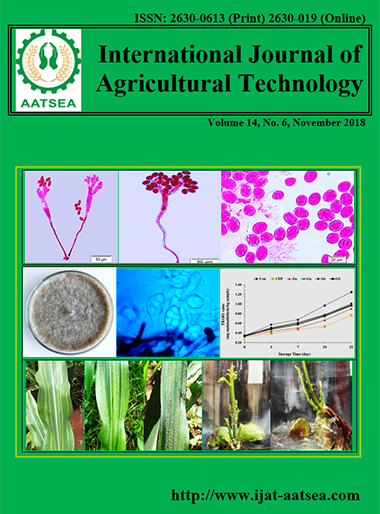Callus Induction and Cell Suspension Culture from Leaves of Kadsura coccinea
Main Article Content
Abstract
Kadsura spp. is a vine glabrous woody which belongs to Schisandraceae that is rare plant found in highland. It is an ancient plant group that low adaptation for living. Shape and scent of fruits like sugar apple, and edible when ripping. It contains the nutrition value and high antioxidants. It is a valuable medicine to prevent the tumor HIV resistant and hepatitis. In presently Kadsura spp. become extinct. The calli from leaves of Kadsura spp. was induced by this study. The leaves were sterilized and cultured on solid synthetic medium, Murashige and Skoog (MS) medium supplement with Plant Growth Regulators (PGRs) were used as 0.5, 1, 2, 3 and 5 mg/L concentrations of 6-benzylaminopurine (BAP), meta-Topolin (mT), 2, 4-dichlorophenol-xyacetic acid (2,4-D) and 0.5 mg/L of BAP combined with 0.5, 1, 2, 3 and 5 mg/L of 2,4-D. The maximum number of leaves were induced calli of 55.55 % and 350.16 mm3 averaged area on medium with 0.5 mg/L of BAP with 0.5 mg/L of 2,4-D, but 0.5 mg/L of BAP with 2 mg/L of 2,4-D gave the highest average area (1,079.53 mm3) after 4 weeks. The growth rate of cell suspension cultured in liquid MS medium supplement with 0.5 mg/l of BAP and 0.5 mg/l of 2,4-D resulted the fresh weight and dry weight of cell suspension with the best grown for 15 days of 1.12 g/10 mL, 0.14 g/10 mL fresh and dry weight respectively. Cell suspension was rapidly grown during the period of 6-15 days. The cell suspension was cultured on MS solid medium combine with 0.5 mg/l of BAP and 0.5 mg/l of 2,4-D and 0.2% (W/V) AC after 4 weeks. The best result for calli induction and perfectly for plant regeneration were the MS medium without AC. This research work is developed an optimized protocol for plant breeding.
Article Details

This work is licensed under a Creative Commons Attribution-NonCommercial-NoDerivatives 4.0 International License.
References
An, E. Y. Han, J. S. and Shin, D. W. (1997). Growth inhibition of Listeria monocytogenes by pure compound isolated from extract of Morus alba line bark (in Korean). Korean Journal of Food Science and Technology. 29:1236-1240.
Antonio, A. B. Magaňa, A. M. Ĺopez, C.B. R. Pěrez, E. S. Contreras, J. C. M. Garćia, Y. G. Toral, F.A. L.D. and Sasa, F. C. (2017). Establishment of callus and cell suspension cultures of Eysenhardtia polystachya (Ortega) and fungistatic activity of their extracts.” South African Journal of Botany. 112:40-47.
De-ping, K., Zeng-shi, W., Yun-qing, X. and He-xia, X. (2008). Inducing and Regeneration of Callus of SANDITI Medicago sativa L. Acta Agriculturae Boreali-Sinica. 2008-S2.
Jia, Z., Dong-chun, J., Hai-lan, J. and Quan-lan, J. (2011). Optimization of Callus Induction Medium for Schisandga Chinensis Baill via Uniform Design. Agricultural Science and Technology. 12:141-143.
Kim, T. D., Anbazhagan, R. V. and Park, J. I. (2004). Somatic embryogesis in Schisandra Chinensis (Turcz.) Baill. In Vitro Cellular and Developmental Biology – Plant. 41:253-257.
Krussmann, G. (1978). Manual of cultivated broad - leaved trees and shrubs. S. ed. PRU-Z Portland:Timber press.
Kvach, J. T. and Veras, J. R. (1982). A Fluorescent Staining Procedure for Determining the Viability of Mycobacterial Cells. International Journal of I.Eprosy. 2:183-192.
Liu, L., Xiao, X., Wang, X., Zheng, R. and Zhou, X. (1984). Effect of ᵞ- schisandrin on the metabolism of DNA, ATP and nucleoprotein of cancer cells. Acta Pharmacol. Sin. 5:130-132.
Lewis, N. G. and Davin, L. B. (1999). Polyketides and other secondary metabolites including fatty acids and their derivatives. Comprehensive natural products chemistry. 1:639-712
Murashike, T. and Skoog, F. (1962). A revised medium for rapid growth and bioassays with tobacco tissue cultures. Journal of Plant Physiology. 15:473-497.
Poeaim, A. (2007). Biotechnology of Plants. Bangkok, Officer of books Faculty Science King Mongkut’s Institute of Technology Ladkrabang.
Poeaim, A. (2007). Biotechnology of Plants Laboratories. Bangkok, Officer of books, Faculty Science King Mongkut’s Institute of Technology Ladkrabang.
Poeaim, A., Poraha, R., Chontong, R., Jantima, O. and Pongjaroenkit, S. (2012). Callus Induction and Cell Suspension Cultures of Khao Pong Krai Rice (Oryza sativa L.) 2182-2188 in The 9th National Kasetsart University Kamphaeng Saen Conference. Nakhon Pathom, Thailand: Kasetsart University Kamphaeng Saen Campus.
Remotti, P. C. (1995). Primary and secondary embryogenesis from cell suspension cultures of Gladiolus” Plant Science. 107:205-214.
Saunders, R. M. K. (2000). Schisandra (Schisandraceae). Systematic Botany Monographs. vol.58 University of Michigan Herbarium, Michigan.
Smiskova, A., Vlasinova, H. and Havel, L. (2005). Somatic embryogenesis from zygotic embryos of Schisandra chinensis. Biologia Plantarium. 49:451-454.
Plant Genetic Conservation Project Office. (1996). An origin and activities of projects. [Online] Available: http://www.rspg.or.th/rspg_eng/origin.htm.


